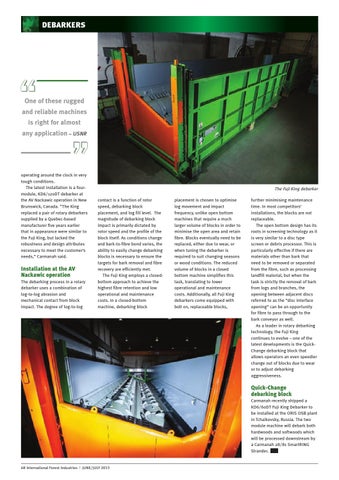IFI_PG66_68_Debarkers_HR 05/07/2013 06:32 Page 68
DEBARKERS
One of these rugged and reliable machines is right for almost any application – USNR
operating around the clock in very tough conditions. The latest installation is a fourmodule, KD6/120DT debarker at the AV Nackawic operation in New Brunswick, Canada. “The King replaced a pair of rotary debarkers supplied by a Quebec-based manufacturer five years earlier that in appearance were similar to the Fuji King, but lacked the robustness and design attributes necessary to meet the customer’s needs,” Carmanah said.
Installation at the AV Nackawic operation The debarking process in a rotary debarker uses a combination of log-to-log abrasion and mechanical contact from block impact. The degree of log-to-log
The Fuji King debarker contact is a function of rotor speed, debarking block placement, and log fill level. The magnitude of debarking block impact is primarily dictated by rotor speed and the profile of the block itself. As conditions change and bark-to-fibre bond varies, the ability to easily change debarking blocks is necessary to ensure the targets for bark removal and fibre recovery are efficiently met. The Fuji King employs a closedbottom approach to achieve the highest fibre retention and low operational and maintenance costs. In a closed-bottom machine, debarking block
placement is chosen to optimise log movement and impact frequency, unlike open bottom machines that require a much larger volume of blocks in order to minimise the open area and retain fibre. Blocks eventually need to be replaced, either due to wear, or when tuning the debarker is required to suit changing seasons or wood conditions. The reduced volume of blocks in a closed bottom machine simplifies this task, translating to lower operational and maintenance costs. Additionally, all Fuji King debarkers come equipped with bolt on, replaceable blocks,
further minimising maintenance time. In most competitors’ installations, the blocks are not replaceable. The open bottom design has its roots in screening technology as it is very similar to a disc type screen or debris processor. This is particularly effective if there are materials other than bark that need to be removed or separated from the fibre, such as processing landfill material, but when the task is strictly the removal of bark from logs and branches, the opening between adjacent discs referred to as the “disc interface opening” can be an opportunity for fibre to pass through to the bark conveyor as well. As a leader in rotary debarking technology, the Fuji King continues to evolve – one of the latest developments is the QuickChange debarking block that allows operators an even speedier change out of blocks due to wear or to adjust debarking aggressiveness.
Quick-Change debarking block Carmanah recently shipped a KD6/60DT Fuji King Debarker to be installed at the ORIS OSB plant in Tchaikovsky, Russia. The two module machine will debark both hardwoods and softwoods which will be processed downstream by a Carmanah 28/81 SmartRING Strander. IFI
68 International Forest Industries | JUNE/JULY 2013
